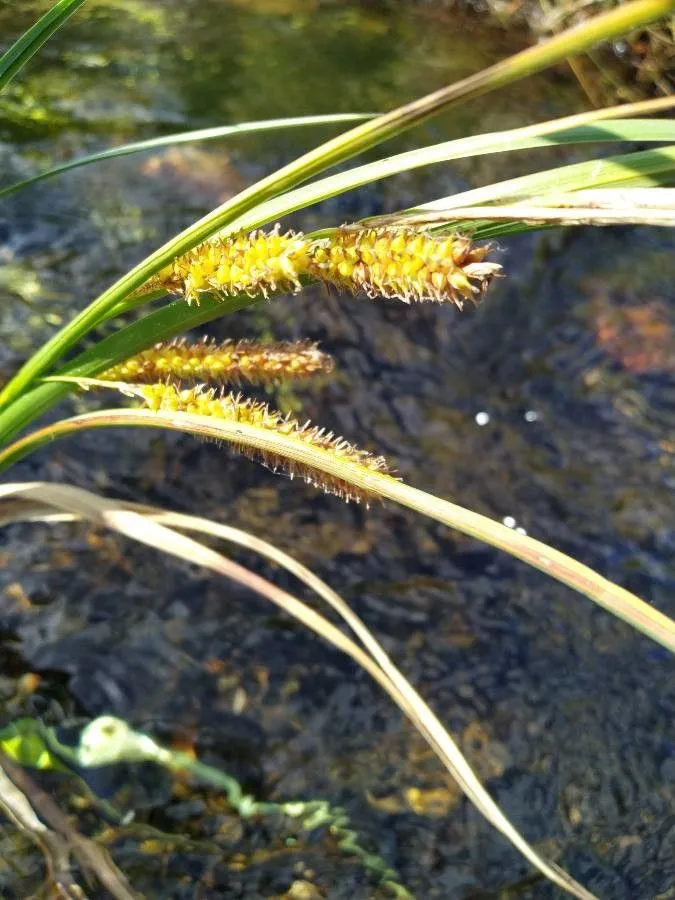
Author: Stokes
Bibliography: W.Withering, Bot. Arr. Brit. Pl. ed. 2. 2: 1059 (1787)
Year: 1787
Status: accepted
Rank: species
Genus: Carex
Vegetable: Unknown
Observations: Subarctic & Temp. Eurasia, Subarctic America to N. U.S.A.
Bottle Sedge, scientifically known as Carex rostrata, is a perennial plant belonging to the Cyperaceae family. Its recognition as a distinct species was first documented by the botanist Stokes in 1787 in W. Withering’s “Botanical Arrangement of British Plants.”
This robust species thrives in various climates, predominantly found in Subarctic and temperate regions across Eurasia and North America. Specifically, its range extends from the Subarctic territories to the northern parts of the United States. Its adaptability to colder climates makes it a vital component of wetland ecosystems in these areas.
Bottle Sedge is characterized by its grass-like appearance and thrives in moist environments such as fens, bogs, and marshes. It typically grows in dense clumps, with stems reaching up to lengths that vary depending on the surrounding habitat conditions. The leaves of the Bottle Sedge are typically long and narrow, contributing to its distinctive tufty appearance.
One of the most notable features of Carex rostrata is its inflorescence. The plant produces spikelets that contain both male and female flowers. The bottle-shaped seed heads, which give the plant its common name, develop after pollination and can be observed throughout the growing season.
Ecologically, Bottle Sedge plays a crucial role in aquatic and semi-aquatic environments. It provides habitat and food for numerous wildlife species, including birds and insects. Its dense root system also helps stabilize soil and reduce erosion, making it an essential plant for maintaining the health and integrity of wetland ecosystems.
For botanists and plant enthusiasts, Carex rostrata is not only of interest for its ecological importance but also for its aesthetic and horticultural value. It is occasionally used in natural landscaping projects to recreate native wetland habitats and promote biodiversity.
In summary, Bottle Sedge (Carex rostrata) is a versatile and ecologically significant plant species that flourishes in the cooler regions of Eurasia and North America. Its distinctive morphology, ecological benefits, and adaptability make it a valuable subject of study and conservation within the diverse Cyperaceae family.
Eng: beaked sedge, bottle sedge, swollen beaked sedge, bottlebrush sedge, narrow-leaved beaked sedge, northern yellow lake sedge, rostrate sedge
Dan: næb-star
Deu: schnabel-segge
Nob: flaskestarr
Nno: flaskestorr
Swe: flaskstarr, pullosara, ljus flaskstarr
Nor: lappesenne, senne-græs, skiæne, sko-senne
Fra: laîche à bec, carex rostré, laiche à utricules contractés en bec, laîche en ampoules
Fin: pullosara
Nld: snavelzegge
Sme: šluppotlukti, rukseslukti
Cym: hesg gylfinfain, hesgen chwysigennaidd ylfinfain, hesgen ylfinfain
En: Bottle sedge, Beaked sedge, Swollen beaked sedge; Northwest Territory sedge, Swollen Beaked Sedge, Bottlebrush sedge, Narrow-leaved beaked sedge, Northern yellow lake sedge, Rostrate sedge, Beaded Sedge
Ar: سعادي منقاري
Be: Асака ўспухлая
Bg: Човчеста острица
Ca: Càrex rostrat
Zh: 灰株苔草, 灰株薹草
Cs: Ostřice zobánkatá
Da: Næb-star
Nl: Snavelzegge
Et: Pudeltarn
Fi: Pullosara
Fr: Laîche à bec, Carex rostré, Laiche à utricules contractés en bec, Laîche en ampoules, Laiche à ampoules, Laîche à ampoules, Laiche à bec, Laiche en vessie, Laîche en vessie, Laîche à utricules contractés en bec
De: Schnabel-Segge, Flaschen-Segge
Hu: Csőrös sás
Is: Tjarnastör
It: Carice rigonfia
Lv: Uzpūstais grīslis
Lt: Snapuotoji viksva
Se: Šluppotlukti, Rukseslukti
No: Flaskestarr, Lappesenne, Senne-græs, Skiæne, Sko-senne
Nb: Flaskestarr
Nn: Flaskestorr
Fa: کارکس رستراتا
Pl: Turzyca dzióbkowata
Ru: Осока носиковая
Sv: Flaskstarr, Pullosara, Ljus flaskstarr
Zh-tw: 灰株苔草
Zh-hant: 灰株苔草
Uk: Осока здута
Cy: Hesgen ylfinfain, Hesg Gylfinfain, Hesgen Chwysigennaidd Ylfinfain
Taken Jan 1, 1900 by EOL − Encyclopedia of Life (cc-by-nc)
Taken Jul 11, 2015 by Tela Botanica − Yoan MARTIN (cc-by-sa)
Taken Jun 30, 2022 by magnus harling (cc-by-sa)
Taken Aug 5, 2020 by Hynninen Mikko (cc-by-sa)
Taken Aug 5, 2020 by Hynninen Mikko (cc-by-sa)
Taken Sep 8, 2018 by Tela Botanica − Jean-Jacques HoudrÉ (cc-by-sa)
Taken Sep 7, 2001 by Tela Botanica − Liliane Roubaudi (cc-by-sa)
Taken Sep 7, 2001 by Tela Botanica − Liliane Roubaudi (cc-by-sa)
Taken Jul 28, 2022 by Peltonen Petri (cc-by-sa)
Taken Jul 14, 2019 by Carlos Villasante (cc-by-sa)
Taken Jul 11, 2015 by Tela Botanica − Yoan MARTIN (cc-by-sa)
Taken Jul 11, 2015 by Tela Botanica − Yoan MARTIN (cc-by-sa)
Taken May 20, 2010 by Tela Botanica − Bruno MACÉ (cc-by-sa)
Taken Jul 11, 2015 by Tela Botanica − Yoan MARTIN (cc-by-sa)
Taken May 20, 2010 by Tela Botanica − Bruno MACÉ (cc-by-sa)
Taken May 15, 2006 by Photoflora – Bernard TILLY (©)
Taken Jul 15, 1997 by Photoflora – Benoit BOCK (©)
Taken Jul 15, 2010 by Photoflora – Benoit BOCK (©)
Taken Jan 1, 1970 by Photoflora – L’Abbé COSTE (©)
Taken Jul 15, 2009 by Photoflora – Benoit BOCK (©)
Taken Jan 1, 1900 by EOL − Encyclopedia of Life (cc-by-nc-sa)
Taken Jan 1, 1900 by EOL − Encyclopedia of Life (cc-by-nc-sa)
Taken Jan 1, 1900 by EOL − Encyclopedia of Life (cc-by-nc-sa)
Taken Jan 1, 1900 by EOL − Encyclopedia of Life (cc-by-nc-sa)
Taken Jan 1, 1900 by EOL − Encyclopedia of Life (cc-by-nc-sa)
Taken Jul 14, 2019 by Carlos Villasante (cc-by-sa)
Taken Jan 1, 1900 by EOL − Encyclopedia of Life (cc-by-nc-sa)
Taken Jul 28, 2015 by Tela Botanica − David MERCIER (cc-by-sa)
Taken Jul 30, 2017 by pierre-etienne allard (cc-by-sa)
© copyright of the Board of Trustees of the Royal Botanic Gardens, Kew.
Family: Myrtaceae Author: (F.Muell.) K.D.Hill & L.A.S.Johnson Bibliography: Telopea 6: 402 (1995) Year: 1995 Status:…
Family: Rubiaceae Author: Pierre ex A.Froehner Bibliography: Notizbl. Bot. Gart. Berlin-Dahlem 1: 237 (1897) Year:…
Family: Sapindaceae Author: Koidz. Bibliography: J. Coll. Sci. Imp. Univ. Tokyo 32(1): 38 (1911) Year:…
Family: Asteraceae Author: A.Gray Bibliography: Pacif. Railr. Rep.: 107 (1857) Year: 1857 Status: accepted Rank:…
Family: Fabaceae Author: Medik. Bibliography: Vorles. Churpfälz. Phys.-Ökon. Ges. 2: 398 (1787) Year: 1787 Status:…
Family: Aspleniaceae Author: (Cav.) Alston Bibliography: Bull. Misc. Inform. Kew 1932: 309 (1932) Year: 1932…